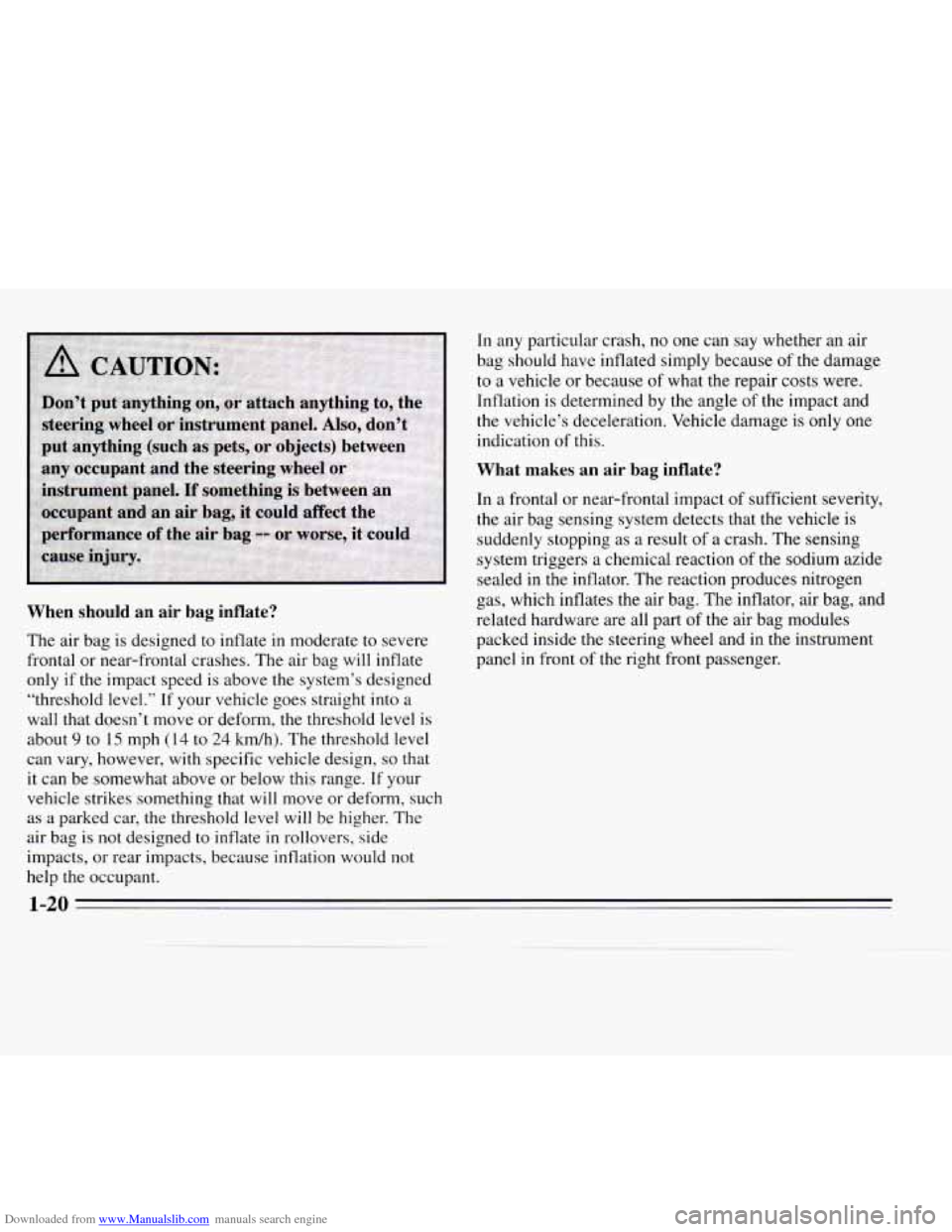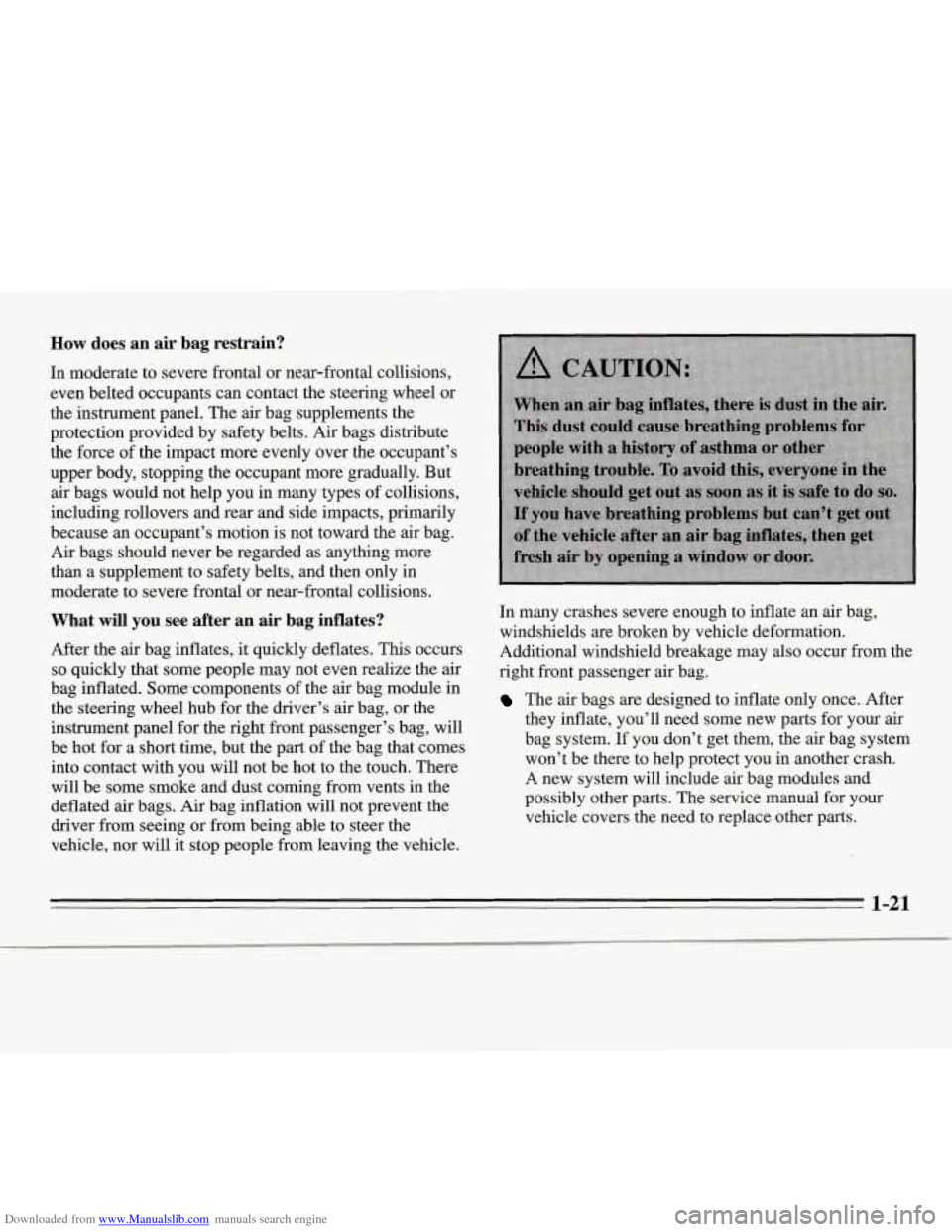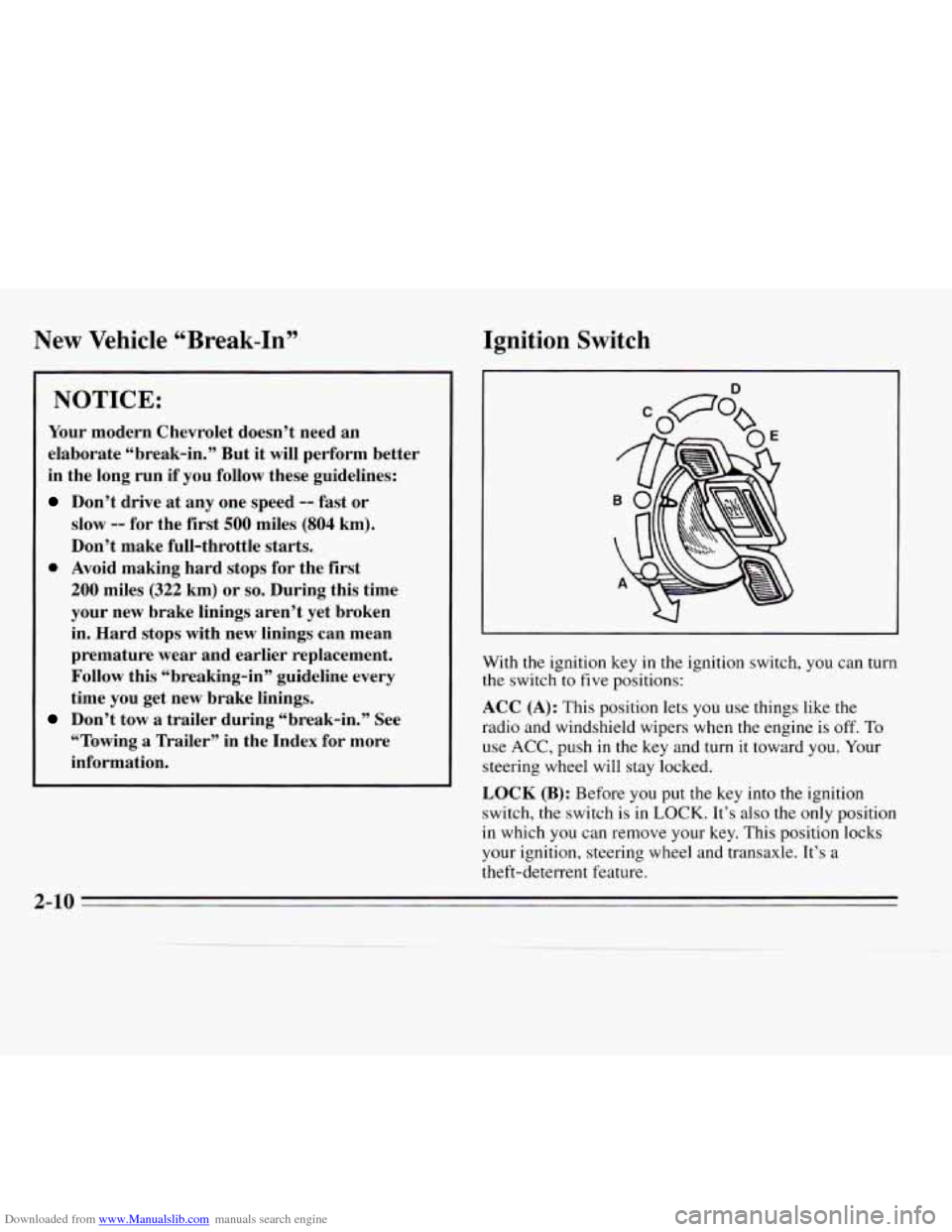Page 5 of 324
Downloaded from www.Manualslib.com manuals search engine The Heritage of Chevrolet ......................
The dynamic William C. ‘iBilly”
Durant shifted gears from making
IY
forming half the team that gave
carriuges
to making curs,
I birth to Chevrolet. I
Louis Chevr-olet, the other half of the team,
at the wheel
of his experimental “Classic
Six,
” which entered production in 1912.
That year 2999 vehicles were produced.
Page 17 of 324
Downloaded from www.Manualslib.com manuals search engine Why Safety Belts Work
When you ride in or on anything, you go as fast as it
goes.
Take the simplest vehicle. Suppose it's
just a seat on
wheels.
Put someone on it.
1-7
Page 29 of 324
Downloaded from www.Manualslib.com manuals search engine How the Air Bag System Works
I
c
Where is the air bag?
The driver’s air bag is in the middle of the steering
wheel. The right front passenger’s air bag is in the
instrument panel
on the passenger’s side.
1-19
Page 30 of 324

Downloaded from www.Manualslib.com manuals search engine When should an air bag inflate?
The air bag is designed to inflate in moderate to severe
frontal or near-frontal crashes. The air bag will inflate
only if the impact speed
is above the system’s designed
“threshold level.” If your vehicle goes straight into a
wall that doesn’t move or deform, the threshold level
is
about 9 to 15 mph (14 to 24 kdh). The threshold level
can vary, however, with specific vehicle design,
so that
it can be somewhat above or below this range. If your
vehicle strikes something that will move or deform, such
as a parked car, the threshold level will be higher. The
air bag is not designed to inflate in rollovers, side
impacts, or rear impacts, because inflation would not
help the occupant. In
any particular crash,
no one can say whether an air
bag should have inflated simply because of the damage
to a vehicle or because of what the repair costs were.
Inflation is determined by the angle
of the impact and
the vehicle’s deceleration. Vehicle damage is only one
indication of this.
What makes an air bag inflate?
In a frontal or near-frontal impact of sufficient severity,
the air bag sensing system detects that the vehicle is
suddenly stopping as a result of a crash. The sensing
system triggers
a chemical reaction of the sodium azide
sealed in the inflator. The reaction produces nitrogen
gas, which inflates the air bag. The inflator, air bag, and
related hardware are all part of the air bag modules
packed inside the steering wheel and in the instrument
panel in front of the right front passenger.
1-20
Page 31 of 324

Downloaded from www.Manualslib.com manuals search engine How does an air bag restrain?
In moderate to severe frontal or near-frontal collisions, even belted occupants can contact the steering wheel or
the instrument panel. The
air bag supplements the
protection provided by safety belts.
Air bags distribute
the force of the impact more evenly over the occupant’s
upper body, stopping the occupant more gradually. But
air bags would not help you in many types of collisions,
including rollovers and rear and side impacts,
primarily
because an occupant’s motion is not toward the air bag.
Air bags should never be regarded as anything more
than a supplement to safety belts, and then only in
moderate to severe frontal or near-frontal collisions.
What will you see after an air bag inflates?
After the air bag inflates, it quickly deflates. This occurs
so quickly that some people may not even realize the air
bag inflated. Somecomponents of the air bag module in
the steering wheel hub for the driver’s air bag,
or the
instrument panel for the right front passenger’s bag, will
be hot for a short time, but the part of the bag that comes
into contact with you will not be hot to the touch. There
will be some smoke and dust coming from vents in the
deflated
air bags. Air bag inflation will not prevent the
driver from seeing or from being able to steer the
vehicle, nor will it stop people from leaving the vehicle. In
many crashes severe enough to inflate an air bag,
windshields are broken by vehicle deformation.
Additional windshield breakage may also occur from the
right front passenger
air bag.
The air bags are designed to inflate only once. After
they inflate, you’ll need some new parts for your
air
bag system. If you don’t get them, the air bag system
won’t be there to help protect you in another crash.
A new system will include air bag modules and
possibly other parts. The service manual for your
vehicle covers the need to replace other parts.
1-21
~
Page 32 of 324

Downloaded from www.Manualslib.com manuals search engine 0 Your vehicle is equipped with a diagnostic module,
which records information about the air bag system.
The module records information about the readiness
of the system, when the sensors are activated and
driver’s safety belt usage at deployment.
0 Let only qualified technicians work on your air bag
system. Improper service can mean that your
air bag
system won’t work properly. See your dealer for
service.
I NOTICE: I
If you damage the cover for the driver’s or the
right front passenger’s air bag, they may not
work properly. You may have to replace the
air
bag module in the steering wheel or both the air
bag module and the instrument panel for the
right front passenger’s
air bag. Do not open or
break the
air bag covers. ,
Servicing Your Air Bag-Equipped
Chevrolet
Air bags affect how your Chevrolet should be serviced.
There are parts of the air bag system in several places
around your vehicle. You don’t want the system to
inflate while someone is working on your vehicle. Your
Chevrolet dealer and the
1995 Monte Carlo Service
Manual have information about servicing your vehicle
and the
air bag system. To purchase a service manual,
see “Service Publications” in the Index.
The air bag system does not need regular maintenance.
1-22
-
Page 64 of 324

Downloaded from www.Manualslib.com manuals search engine Glove Box
Use the door key to lock and unlock the glove box. To
open, lift the latch.
Theft
Vehicle theft is big business, especially in some cities.
Although your Chevrolet has a number of theft deterrent
features, we know that nothing we put on it
can make it
impossible to steal. However, there are ways you can help.
Key in the Ignition
If you walk away from your vehicle with the keys
inside, it’s
an easy target for joy riders or professional
thieves
-- so don’t do it. When you
park your Chevrolet and open the driver’s
door, you’ll hear a chime reminding you
to remove your
key from the ignition and take it with you. Always do
this. Your steering wheel will be locked, and
so will
your ignition and transaxle. And remember to lock the
doors.
Parking at Night
Park in a lighted spot, close all windows and lock your
vehicle. Remember to keep your valuables out
of sight.
Put them in
a storage area, or take them with you.
Parking Lots
If you park in a lot wheresomeone will be watching
your vehicle, it’s best
to lock it up and take your keys.
But what
if you have to leave your ignition key? What if
you have to leave something valuable in your vehicle?
0 Put your valuables in a storage area, like your trunk
or glove box.
0 Lock the glove box.
0 Lock all the doors except the driver’s.
0 Then take the door key with you.
2-8
Page 66 of 324

Downloaded from www.Manualslib.com manuals search engine New Vehicle “Break-In” Ignition
Switch
NOTICE:
Your modern Chevrolet doesn’t need an
elaborate “break-in.” But it will perform better
in the long run if you follow these guidelines:
Don’t drive at any one speed -- fast or
slow -- for the first 500 miles (804 km).
Don’t make full-throttle
starts.
200 miles (322 km) or so. During this time
your new brake linings aren’t yet broken
in. Hard stops with new linings can mean
premature wear and earlier replacement.
Follow this “breaking-in” guideline every
time you get new brake linings.
Don’t tow a trailer during “break-in.” See
“Towing
a Trailer” in the Index for more
information.
0 Avoid making hard stops for the first
With the ignition key
in the ignition switch, you can turn
the switch
to five positions:
ACC
(A): This position lets you use things like the
radio and windshield wipers when the engine is off.
To
use ACC, push in the key and turn it toward you. Your
steering wheel will stay locked.
LOCK
(B): Before you put the key into the ignition
switch, the switch is in LOCK.
It’s also the only position
in which you can remove your key. This position locks
your ignition, steering wheel and transaxle. It’s
a
theft-deterrent feature.
2-10